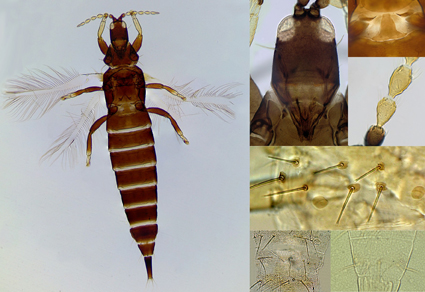Abstract
Haplothrips biroi (Priesner) is known from several southern European countries and is here newly recorded from southwestern Slovakia. The host plant is confirmed as Ballota nigra [Lamiaceae], with 107 female and 25 male adults collected, and the species successfully reared on the host leaves. Key morphological features of adults and larvae are illustrated, and the ecological implication of the record briefly discussed.
References
- Donchev, K. (1993) Contribution to the studies on order Thysanoptera in Bulgaria IV. The proceedings of the Second National Scientific Conference of Entomology, Sofia, 25–27 October 1993, 7–8. [in Bulgarian]
- Jenser, G. (1979) A check-list of Thysanoptera of Hungary. Folia Entomologica Hungarica, 22 (2), 31–42.
- Karadjova, O. & Krumov, V. (2015) Thysanoptera of Bulgaria. ZooKeys, 504, 93–131. https://doi.org/10.3897/zookeys.504.9576
- Knechtel, W.K. (1960) Phaenologische Forschungen über Thysanopteren (Die Thysanopteren der Dobrogeasteppe). XI. Internationaler Kongreß für Entomologie (Proceedings), 489–493. [in German]
- Kucharczyk, H., Kucharczyk, M. & Saj, I. (2024) Morphology of Neoheegeria dalmatica Schmutz, 1909 (Thysanoptera, Phlaeothripidae) larvae – their diagnostic characteristics. Zootaxa, 5489 (1), 144–152. https://doi.org/10.11646/zootaxa.5489.1.10
- Kucharczyk, H. & Stanisławek, K. (2020) Haplothrips second instar larvae (Thysanoptera: Phlaeothripidae); character states and key to Central European species. Zootaxa, 4845 (3), 375–392. https://doi.org/10.11646/zootaxa.4845.3.4
- Marullo, R. (2004) Host-plant range and relationships in the Italian thrips fauna. Acta Phytopathologica et Entomologica Hungarica, 39, 243–254. https://doi.org/10.1556/aphyt.39.2004.1-3.23
- Marullo, R. & De Grazia, A. (2013) The introduced species over the last twenty years in the Italian Thrips Fauna. Die Bodenkultur, 66 (4), 27–31.
- Minaei, K., Azemayeshfard, P. & Mound, L. (2007) The southern Palaearctic genus Neoheegeria (Thysanoptera: Phlaeothripidae): redefinition and key to species. Tijdschrift voor Entomologie, 150, 55–64. https://doi.org/10.1163/22119434-900000212
- Mound, L.A. (2013) Homologies and host-plant specificity: Recurrent problems in the study of thrips. Florida Entomologist, 96 (2), 318–322. https://doi.org/10.1653/024.096.0250
- Mound, L.A. & Kibby, G. (1998) Thysanoptera: An Identification Guide. CAB international, Wallingford, New York, 78 pp.
- NHM (Natural History Museum) (2025) Natural History Museum (London) Collection Specimens. Occurrence dataset. Available from: https://www.gbif.org/occurrence/3710643328 (accessed 7 April 2025)
- Pelikán, J. (1992) Faunistic records from Czechoslovakia. Acta Entomologica Bohemoslovaca, 88, 11–12.
- Priesner, H. (1928) Beiträge zur Kenntnis der europäischen Tysanopteren. Konowia, Vienna, 7, 322–325.
- Priesner, H. (1964) Ordnung Thysanoptera: (Fransenflügler, Thripse). Akademie-Verlag, Berlin, 242 pp. https://doi.org/10.1515/9783112760437
- Schliepake, G. & Klimt, K. (1979) Thysanoptera, Fransenflügler. Veb Gustav Fischer Verlag Jena, 466 pp. [in German]
- Tichý, L., Axmanová, I., Dengler, J., Guarino, R., Jansen, F., Midolo, G., ... Chytrý, M. (2023) Ellenberg-type indicator values for European vascular plant species. Journal of Vegetation Science, 34 (e13168), 1–13. https://doi.org/10.1111/jvs.13168
- Vasiliu-Oromulu, L. (1998a) The geographical distribution of Romanian Thysanoptera species (Insecta: Thysanoptera). Entomologica Romanica, 3, 67–72.
- Vasiliu-Oromulu, L. (1998b) Lista revizuită a speciilor de thysanoptere (Insecta: Thysanoptera) din România. Studii și Cercetări de Biologie, 50 (2), 77–83. [in Romanian]
- Vasiliu-Oromulu, L. (1998c) Speci de thysanoptere din Romania: aspecte ecologice (Insecta: Thysanoptera). Studii și Cercetări de Biologie, 50 (2), 85–96. [in Romanian]
- Vierbergen, B. (2004) Neoheegeria biroi Priesner, 1928. Available from: http://www.faunaeur.org/full_results.php?id=90555 (accessed 18 February 2025)
- zur Strassen, R. (1987) On some Thysanoptera of an agricultural area located on woody slopes in Northern Umbria, Italy. Redia, 70, 203–228.
- Zvaríková, M., Masarovič, R., Prokop, P. & Fedor, P. (2020) An updated checklist of thrips from Slovakia with emphasis on economic species. Plant Protection Science, 56, 292–304. https://doi.org/10.17221/87/2020-PPS


